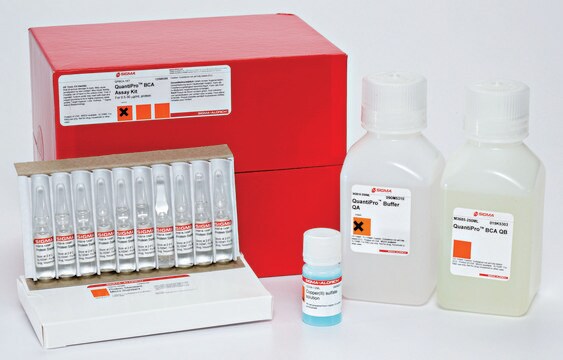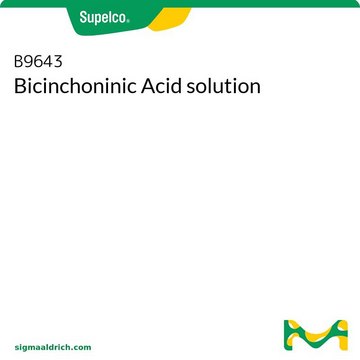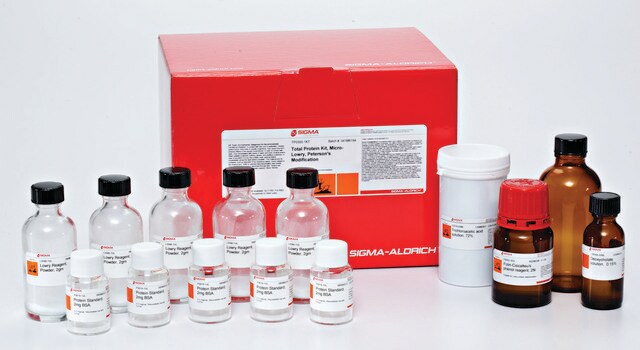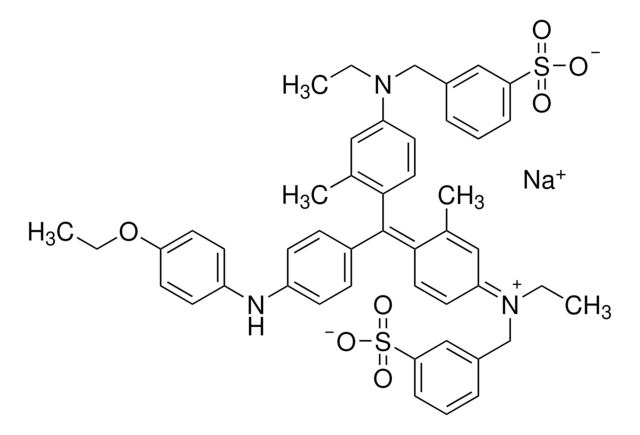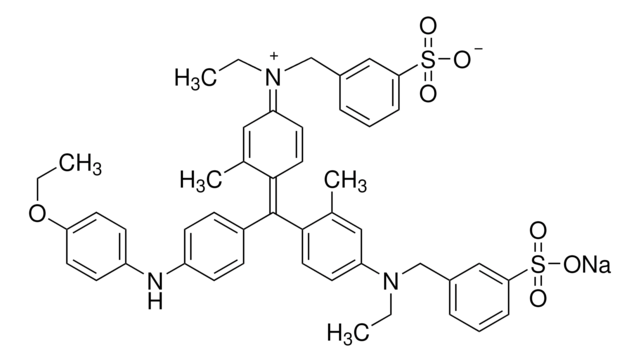FP0010
FluoroProfile™ Protein Quantification Kit
Faça loginpara ver os preços organizacionais e de contrato
About This Item
Código UNSPSC:
12352200
Produtos recomendados
Condições de expedição
wet ice
temperatura de armazenamento
−20°C
Aplicação
Reversible covalent binding to proteins by the fluorophore epicocconone provides a powerful and sensitive method for protein quantification
Características e benefícios
- Yields an intense fluorescent red on protein binding
- Binding is completely reversible making the protein suitable for mass spectrometry and functional assays
- Water soluble proteins may be quantified without using organic solvents
- A large dynamic range, large Stokes shift and highly sensitive
- Highly tolerant of substances commonly interfering with protein quantification
- Biodegradable and environmentally friendly
Outras notas
For the quantification of total protein in solution by the interaction of a unique fluorophore with the amines of polypeptides.
Informações legais
FluoroProfile is a trademark of Sigma-Aldrich Co. LLC
Componentes do kit também disponíveis separadamente
Nº do produto
Descrição
SDS
- P5619Protein Standard, analytical standard, 2 mg/vial BSASDS
Palavra indicadora
Warning
Frases de perigo
Declarações de precaução
Classificações de perigo
Eye Irrit. 2
Código de classe de armazenamento
10 - Combustible liquids
Classe de risco de água (WGK)
WGK 3
Ponto de fulgor (°F)
Not applicable
Ponto de fulgor (°C)
Not applicable
Certificados de análise (COA)
Busque Certificados de análise (COA) digitando o Número do Lote do produto. Os números de lote e remessa podem ser encontrados no rótulo de um produto após a palavra “Lot” ou “Batch”.
Já possui este produto?
Encontre a documentação dos produtos que você adquiriu recentemente na biblioteca de documentos.
Phillip J L Bell et al.
Journal of the American Chemical Society, 125(31), 9304-9305 (2003-08-02)
Epicocconone represents a new class of natural fluorescent probes based on a polyketide skeleton isolated from the fungus Epicoccum nigrum. Epicocconone is a small, cell permeable natural product with a high molar absorbtivity and a long Stokes' shift that will
Ondřej Kaplan et al.
PloS one, 11(10), e0163697-e0163697 (2016-10-08)
We describe the production of a highly-active mutant VEGF variant, α2-PI1-8-VEGF121, which contains a substrate sequence for factor XIIIa at the aminoterminus designed for incorporation into a fibrin gel. The α2-PI1-8-VEGF121 gene was synthesized, cloned into a pET-32a(+) vector and
R P Ubrihien et al.
Archives of environmental contamination and toxicology, 82(4), 520-538 (2022-04-21)
The effects of multigenerational Cu exposure on the freshwater gastropod Isidorella newcombi were investigated. Snails were exposed to a range of treatment-specific Cu concentrations in the parental to F2 generations, and a common Cu concentration in the F3 generation. In
Helena A Schmitz et al.
Aquatic toxicology (Amsterdam, Netherlands), 160, 22-30 (2015-01-13)
Metals are accumulated by filter feeding organisms via water, ingestion of suspended sediments or food. The uptake pathway can affect metal toxicity. Saccostrea glomerata were exposed to cadmium through cadmium-spiked suspended sediments (19 and 93μg/g dry mass) and cadmium-enriched phytoplankton
Anne M Taylor et al.
Comparative biochemistry and physiology. Toxicology & pharmacology : CBP, 166, 34-43 (2014-07-11)
The metalloid selenium is an essential element which at slightly elevated concentrations is toxic and mutagenic. In Australia the burning of coal for power generation releases selenium into estuarine environments where it accumulates in sediments. The relationship between selenium exposure
Nossa equipe de cientistas tem experiência em todas as áreas de pesquisa, incluindo Life Sciences, ciência de materiais, síntese química, cromatografia, química analítica e muitas outras.
Entre em contato com a assistência técnica

